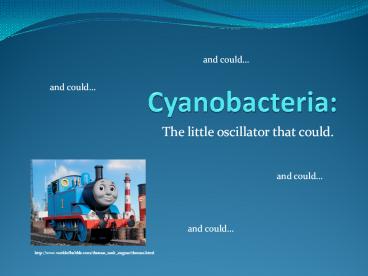Cyanobacteria: PowerPoint PPT Presentation
Title: Cyanobacteria:
1
Cyanobacteria
and could
and could
- The little oscillator that could.
and could
and could
http//www.worldofbubble.com/thomas_tank_engine/th
omas.html
2
Background
- Some strains of cyanobacteria oscillate on a
circadian cycle. This cycle is driven by the
interaction of three proteins, KaiABC, which are
sufficient to produce oscillation in vitro
without transcription regulation (Nakajima et
al., 2005). - Cyanobacteria oscillation is robust and
temperature-independent (within living
tolerances). - The oscillation period can be adjusted from
14-60hours by point mutations of KaiC (Kondo et
al., 2000).
3
The Represillator The oscillator that couldnt
really. Reference (Elowitz et al. 2000)
- Transcriptional repression system
- Plasmid to right, GFP reporter
- Lite means destruction tag
- T200min
- Is not stable over time
- Advantages of Cyanobacteria oscillator
- Stable over time
- Potentially more robust due to evolutionary
development - Post translational mechanism means less energy?
- Problem with implementation in later generations
- According to Elowitz
- However, the reliable performance of
cyanobacteria circadian oscillators can be
contrasted with the noisy, variable behavior of
the repressilatorIt would be interesting to see
whether one could build an artificial analogue of
the circadian clock.
4
Goals
Deliverable Bacterial Nightlight in E. coli
Fallback Bacterial Nightlight in Cyanobacteria
- Intermediate Goals
- Use Kai sequence to create a functional
oscillator Biobrick. - Use a luciferase gene reporter to measure Kai
activity (e.g. GFP). - Use oscillator with luciferase to construct a
nightlight.
http//www.footvolley.net/images/ronaldo20world2
0cup20goal.jpg
5
Timeline
- Obtain an appropriate strand of cyanobacteria
(1-2 wks) - Contact MIT iGem team for leads
- Synechococcus PCC7942 or WH8102
- Extract the KaiABC genes from cyanobacteria and
biobrick them (1-2 wks) - Design of primers can be done beforehand
- Design a feasible E. coli sequence for KaiABC,
and synthesize it (can be done in parallel with
step 1) (1-2 wks) - Research the modifications we will need to make
to the cyanobacteria genes to make them
compatible with E. Coli if theyre small, we
wont need to synthesize the whole sequence. - Instead of synthesizing entire 3kb sequence,
break into smaller sequences to be synthesized
separately to save on cost, and recombine by PCR. - Insert both sequences (synthesized and BioBrickd
from cyanobacteria) into E. Coli and test (5 wks)
6
Risks
- There is a known codon bias problem with 2 amino
acids - Possible resolution to codon bias we can
synthetically modify the codons for the 2 amino
acids to be compatible in e. coli - Other environmental factors in E. coli may hinder
the oscillator - More proteins may be involved than KaiABC
- But KaiABC have been shown to work in vitro
- Problems with synthesis of KaiABC
- Not obtaining the cyanobacteria from various
sources - This can be resolved by using alternative methods
of synthesis - Testing
- Test three plasmids attached to KaiA, KaiB, and
KaiC - Loss of time, effort, and resources
- Resolved by implementing intermediate goals such
as a "nightlight" in cyanobacteria, not E. coli
http//www.compendia.co.uk/acatalog/risk.jpg
7
Testing
- Problem
- Not obvious how to wire clock output to other
cell activities (like transcription) in E. coli
without the complex and partially nebulous
circadian elements in cyanobacteria.
Possible Solutions Directly measure the amount
of KaiC phosphorylation using antibody staining.
But this doesnt help us make the cell do any
useful work.
8
Rewards/Motivation
Robustness The repressilator destabilizes over time, but our oscillator will retain its period and amplitude after long periods of time.
Variability Can experimentally vary the period of oscillation from 14h to 60h (Kondo et. al 2000) with KaiC point mutations.
Useful Applications Can implement a clock or timer in gene circuits analogous to similar parts in silico, and trigger events at certain times.
iGem Performance A robust Biobricked oscillator, and its application in our system, will impress iGem judges.
Team effort Creating a working oscillator will require each of us to contribute our respective strengths C.S. for modeling, Biochemistry for understanding and implementing the circuitry.
Fun Factor Strong.
9
Fin.

